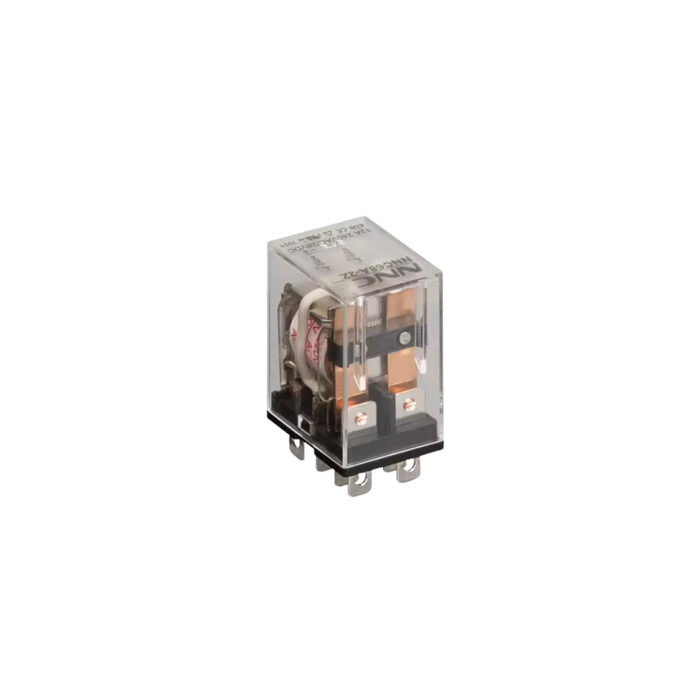
Electromagnetic Relay
Description
Electromagnetic Relay: A Comprehensive Guide
An electromagnetic relay is an electrically operated switch that uses the principle of electromagnetism to open or close a circuit. It is widely used in various electronic and electrical systems to control high-power devices with low-power signals. Electromagnetic relays are crucial components in automation, control systems, and protection circuits, among other applications.
What is an Electromagnetic Relay?
An electromagnetic relay consists of a coil, an armature, and contacts. When an electric current flows through the coil, it generates a magnetic field that attracts the armature, causing it to move. This movement opens or closes the relay's contacts, allowing or interrupting the flow of electricity through the circuit. The relay’s contacts can be used to control larger currents and voltages with a small input signal.
Key Features of Electromagnetic Relays
-
Electromagnetic Operation: Works by using an electromagnet to control the movement of the contacts.
-
Isolation: Provides electrical isolation between the control circuit and the high-power circuit.
-
Versatile Contact Configurations: Available in various contact arrangements, such as single-pole single-throw (SPST), double-pole double-throw (DPDT), and others.
-
High Durability: Can handle a large number of operations before wear and tear.
-
Compact Size: Small and efficient for many control applications.
Types of Electromagnetic Relays
-
General Purpose Relays: Used in basic switching operations for a wide range of applications, such as controlling lights or motors.
-
Automotive Relays: Specially designed to handle the specific needs of automotive circuits, such as controlling high-power devices in vehicles.
-
Timing Relays: Used for delay or timing operations in circuits, controlling devices based on set time intervals.
-
Solid-State Relays: A type of relay that uses semiconductor components rather than mechanical contacts for switching.
-
Overload Protection Relays: Used to protect motors and other devices from overload by detecting excessive current or temperature and triggering the relay to interrupt the power.
How an Electromagnetic Relay Works
-
Coil Energized: When current flows through the coil of the relay, it generates a magnetic field.
-
Armature Movement: The magnetic field attracts a movable armature, which is connected to the relay’s contacts.
-
Contact Switching: The movement of the armature opens or closes the contacts, completing or interrupting the flow of current in the circuit.
-
Coil De-energized: When the current to the coil is turned off, the magnetic field collapses, and a spring returns the armature to its original position, resetting the contacts.
Common Applications of Electromagnetic Relays
-
Home Automation: Used to control lights, fans, and other appliances in smart homes.
-
Automotive Systems: Control systems such as headlights, fuel pumps, and ignition circuits.
-
Industrial Control Systems: Used in PLCs (Programmable Logic Controllers) to switch large machines or devices based on control signals.
-
Telecommunications: Used to route signals and control circuits in telecommunication systems.
-
Overload Protection: Protects electrical devices, such as motors, from overcurrent conditions.
Benefits of Electromagnetic Relays
-
Electrical Isolation: They provide safe electrical isolation between the control circuit and the high-power circuit.
-
High Current Switching: Relays can control high-current devices with low-power control signals, offering versatility in automation.
-
Cost-Effective: Compared to solid-state devices, electromagnetic relays are typically more affordable for many applications.
-
Reliable: They offer a reliable method of switching, with minimal wear and tear, especially when used for simple on/off applications.
How to Choose the Right Electromagnetic Relay
When selecting an electromagnetic relay, consider the following factors:
-
Current and Voltage Rating: Ensure the relay can handle the current and voltage of the circuit it will control.
-
Coil Voltage: The voltage required to energize the coil should be compatible with the control circuit.
-
Contact Configuration: Choose the right type of contacts (e.g., SPST, DPDT) based on your switching needs.
-
Switching Time: Depending on the application, the relay should have an appropriate response time for switching.
-
Mechanical Life: Consider the expected number of operations the relay should handle over its lifetime.
Specifications
Shipping
At DTF Bank, we use trusted carriers to ensure your spare parts are delivered safely and promptly, offering shipping methods such as ground or air.
Orders for spare parts placed before 2 PM Central Time (CT) are shipped the same business day to get your products to you as quickly as possible. Orders received after this time will be shipped the next business day.
Shipping costs will be calculated at checkout based on the location provided, the shipping option selected, and the total weight of the purchase.
Currently, DTF Bank does not offer international shipping and ships exclusively within the United States to focus on delivering the best possible service to our domestic customers.
DTF Bank is not responsible for any delays that occur after the package is handed over to the shipping company.
While we strive to meet all delivery times, there may be occasions due to unforeseen circumstances where deliveries could be delayed. We appreciate your understanding and patience in these instances.
For more details, check out our Shipping Policy.
